
Click here to view image
Decorative cuffs, circa 1880 (Ojibway)
Cloth, tape, glass countries (covered-stitch embroidery)
Decorative cuffs for men’s dress with floral embroidery (French in origin)

Click here to view image
Decorative cuffs, circa 1880 (Ojibway)
Cloth, tape, glass countries (covered-stitch embroidery)
Decorative cuffs for men’s dress with floral embroidery (French in origin)


Click here to view image
Shamanic necklace, circa 1870 (East Dakota, Yankton)
Tanned leather, glass countries (in envelopes and "salt & pepper" decoration), metal rattles

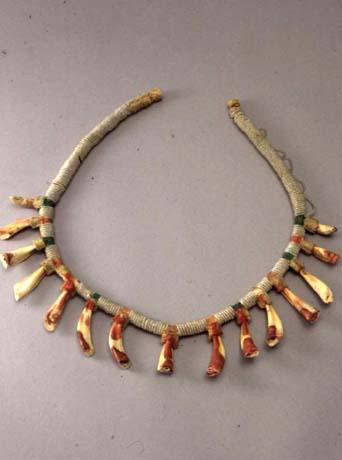
Click here to view image
Men’s necklace, circa 1870 (East Dakota, Yankton)
Tanned leather, glass counties (in envelope), 15 horse teeth (?)
The owner was identified as a great quadruped breeder

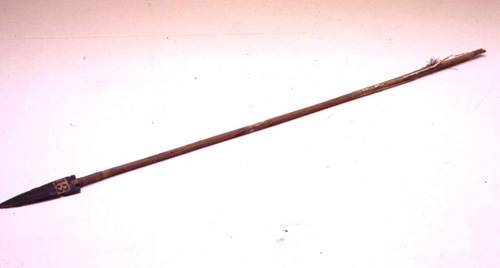
Click here to view image
Ceremonial arrow, circa 1870 (Teton Dakota)
Rod made of dehusked ash wood, feathers, chipped and polished buffalo horn, animal fibre
Ceremonial arrow (perhaps). The rod is crossed by a zigzag engraved motif that symbolized lightning and lightning; there are also traces of red paint that identified the owner

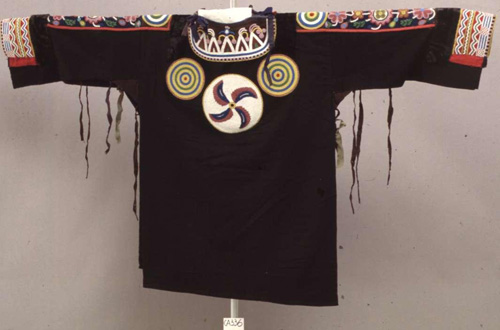
Click here to view image
Tunic
Collezione Missioni Cattoliche Americane 1893
Tunic
XIX - 1890 - 1890
C.A.336
Canada
La casacca faceva parte dell'abbigliamento maschile e originariamente era realizzata con due pezzi di pelle di cervide conciata cucite lateralmente a formare una sorta di poncho. In un periodo più tardo, in seguito al contatto e ai conseguenti scambi con i bianchi, il modello tradizionale fu influenzato dagli abiti degli europei e la pelle fu sostituita da tessuto. Le decorazioni potevano essere realizzate con frange, pitture, aculei di porcospino, che venivano divisi a seconda della misura, ammorbiditi in bocca e, presso alcune tribù, spaccati; quindi erano appiattiti con i denti o con le unghie e conterie di vetro. Le decorazioni variavano a seconda delle tribù: più sobrie nelle pianure del sud e più ricche al nord. Per la conciatura la pelle veniva tesa su dei pioli e con un raschiatoio si eliminavano residui di carne e cartilagini, quindi veniva lasciata stesa al sole ad asciugare per parecchi giorni. A questo punto la pelle veniva capovolta per rimuovere il pelo, tenuta a mollo e strofinata con una mistura di grassi animali per ammorbidirla. Dopo averla lasciata nuovamente ad asciugare, veniva stirata e lavorata sulle due facce con una correggia ritorta di cuoio grezzo.
Protezione/estetico-ornamentale. Cerimonie.
Tunic made from four rectangular pieces of black cloth sewn together only at the shoulders and around the sleeve and fastened at the sides and under the sleeves by knotted cotton ribbons. The front and back are each decorated with three discoidal leather appliqués, the central one with a pinwheel motif and the two side ones with concentric circles, made of white, yellow, blue, red, green and blue glass beads. The neckline, both on the front and back, is decorated with two shaped applications made of black cloth with geometric and floral motifs in white, green, red, pink, yellow and azure glass beads bordered by a band of alternating white, azure, pink and yellow glass beads. Along each sleeve is sewn a rectangular blue cloth appliqué bordered by a red ribbon and decorated on the shoulder with a disc in concentric circles and on the arm with a floral motif in white, yellow, red, light and dark green, light blue, silver, pink and blue conteries. On the wrist of each sleeve is sewn a rectangular red cloth appliqué decorated in bands with geometric motifs in green, yellow, white, blue and pink glass beads. Four rectangles of black and brown velvet are sewn in pairs horizontally on the lower part of the sleeve and vertically on the shoulders. The tunic was part of men's clothing and was originally made of two pieces of tanned deer skin sewn sideways to form a kind of poncho. In a later period, as a result of contact and subsequent trade with whites, the traditional pattern was influenced by the clothing of Europeans and the leather was replaced by fabric. Decorations could be made with fringes, painting, porcupine quills, and glass beads. Decorations varied according to tribe: more sober in the southern plains and richer in the north. This type of floral decoration was of French derivation.

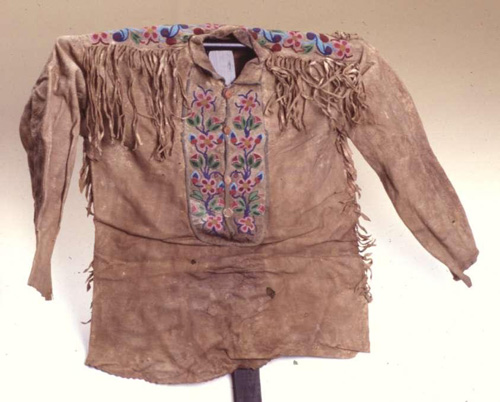
Click here to view image
Male tunic, 1870 - 1880 circa (Ojibway, probably object of exchange with the Dakota)
Tanned cervid leather, glass (covered stitch embroidery), fabric, wooden buttons
Male tunic with floral embroidery (French-style), with fringes (typical of Dakota)

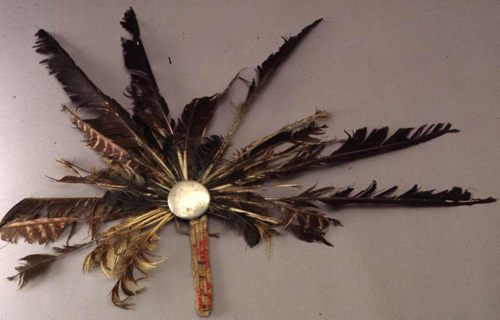
Click here to view image
Ornament for the head, end of 800 (Plains Indians)
Feathers (in 3 overlapping layers: hawk, eagle and owl), "false silver" - German silver, porcupine tail, porcupine spines (flattened by teeth or nails, dyed and sewn)
Ornament for the head (it was applied to the hair on the nape of the most valiant warriors)

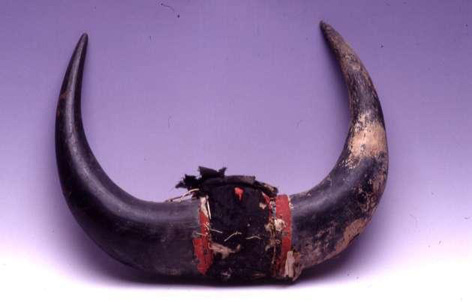
Click here to view image
Buffalo horns, 1865 - 1875 circa (West Dakota, Brulee)
Buffalo horn, fabric, wool, metal, wood
Buffalo horns (terminal ceremonial staff, used in the dances preceding the buffalo hunt)

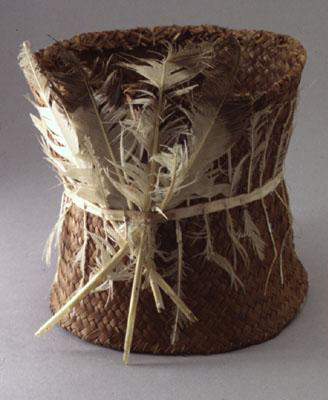
Click here to view image
Male headdress, circa 1880 (Ojibway)
Braided vegetable fiber, Great Lakes goose feathers, fabric

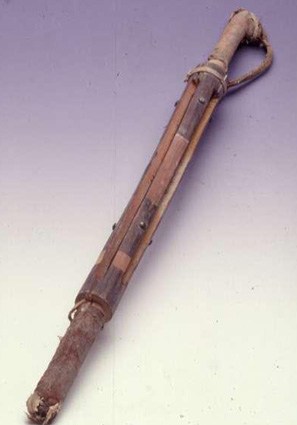
Click here to view image
Ceremonial mace, end of 800 (East Dakota, Yankton)
Leather, stone, decorticated, sanded, carved and painted wood, cotton and metal thread
Ceremonial club, symbol of status, flaunted on convivial occasions (like the Pow - Wow)




Headquarters:
Municipality of Genoa - Palazzo Tursi
Via Garibaldi 9 - 16124 Genoa
C.F / VAT 00856920102